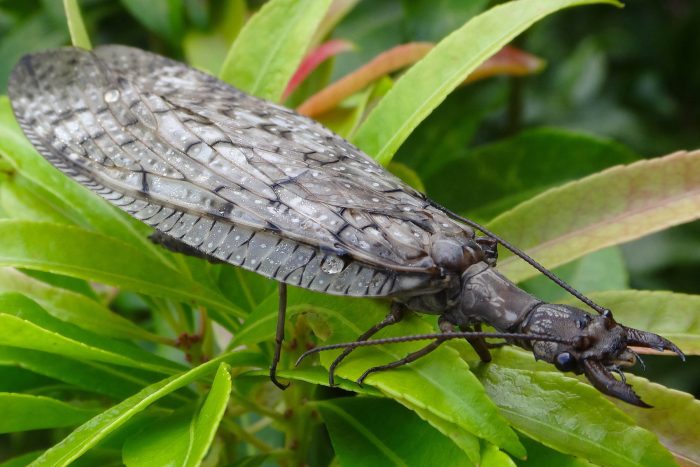Eastern Dobsonfly
Corydalus cornutus
The eastern dobsonfly is a large nocturnal insect that can be an important indicator of stream health.
This section shows one large critter image at a time. Use the thumbnails that follow to select a specific image to display here.

This gallery contains a grid of small thumbnails. Selecting a thumbnail will change the main image in the preceding section.
Appearance
Dobsonfly larvae, also known as hellgrammites, have long, brown and flat bodies with large pincers on their heads. They have a segmented abdomen, with each segment containing a set of legs and feathery gills. Larvae grow up to three inches in length, while adult dobsonflies can grow to be up to four inches in length. They are a brown-gray color with large, veined wings that cover most of their mottled body. The wings typically have white spots. Both males and females have curved mandibles, but the males are significantly larger and can grow up to one inch in length. Both males and females have long antennae.
Feeding
Dobsonfly larvae will eat almost anything they can catch. Dobsonflies do not usually feed during their adult stage.
Predators
Dobsonfly larvae are eaten by fish. Adult dobsonflies are eaten by birds.
Reproduction and life cycle
The life cycle of dobsonflies is significantly impacted by the climate in which they live. In southern areas, dobsonflies can go through all their developmental stages in one year, but in northern areas, it can take several years to go through them all. Female dobsonflies lay eggs in clusters on plants near streams. Each egg cluster can contain up to 3,000 eggs. When the eggs hatch, the larvae fall into the water and move with the current until they find a suitable habitat. Dobsonflies can remain in their larval stage for up to four years. When the conditions are right, they will emerge from the stream and dig a hole which acts as their cocoon. When they emerge as adults, they will live for less than two weeks. As adults their sole focus is reproduction.
Did you know?
- As larvae, dobsonflies rely on clean, fast-flowing water with a rocky bottom. Their sensitivity to pollutants makes them a good indicator of stream health.
- Dobsonflies are one of the largest aquatic insects in North America.
- Hellgrammites are a popular bait for anglers.
- Although the male’s mandibles may look intimidating, they are incapable of delivering a painful bite. Males only use the large mandibles to compete with opposing males. However, the mandibles of larvae and females can cause a painful bite.
Sources and additional information
- Eastern Dobsonfly Larva (Hellgrammite) - Mountain Lake Biological Station
- Large and Unusual Insects Found in Virginia - Virginia Cooperative Extension
- What is that strange big insect? Dobsonflies, hellgrammites, and fishflies (Corydalidae) - Bug of the Week
